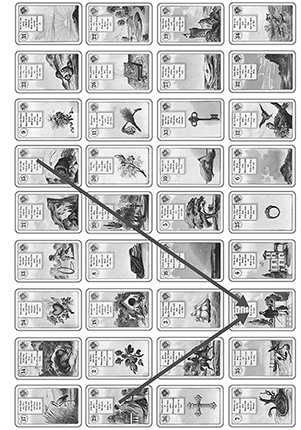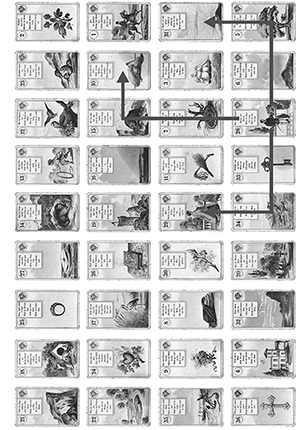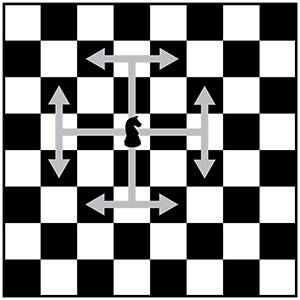Knighting, Counting,
and Diagonals
Free will is the key-note of all Dame Nature’s efforts, and every one of us is
master of his own destiny, within the limitations of his own personality.
Bear that in mind when you read the cards. Never state that a thing
will happen, but that it appears probable in the present course of affairs.
—Charles Platt, Card Fortune Telling, 1921
Accessing Your Inner Sibyl
Before we discuss these advanced techniques, we first remind ourselves to access our own inner sibyl. Having set the scene for a reading from the “cards of antiquity,” we should be mindful to move ourselves into a particular mindset suited for Lenormand reading—again, one different from tarot.
To access your inner sibyl, you need to release yourself from your own inner critic. You must respect that quiet, sacred side of yourself that has always known what lies beyond the here and now. The inner sybil is the part of yourself that wants to perform without care of what people may think.
It is the side of ourselves allowed to roam with no repression. It does not mean you have to dress in Romantic-style Romani clothes, wearing gold rings in your ears (however this is optional!). It was Heraclitus, the Greek philospher, who spoke of the sibyl’s abandonment of speech that was above ridicule. The divine alone would project forth her oracular message:
“The Sibyl, with frenzied mouth uttering things not to be laughed at, unadorned and unperfumed, yet reaches to a thousand years with her voice by aid of the god.”
To access your inner sibyl, you must not try to do so; it must be something that comes to you. When ready, it will come forth when the words are expected.
Knighting
The idea of knighting appears to have derived from Iris Treppner’s work, and the concept of shadowing is something we personally use in contemporary readings of our Lenormand. It is similar in a sense to the idea of reflections, which again comes from earlier methods.
There are many schools of thought you can explore with the Lenormand system, as it is relatively untrammelled in English, perhaps accounting for its new popularity. However, all of them are as constructed or derivative as any other offering, since we do not know exactly how Mlle. Lenormand read her cards, nor do we have consistent “fixed” meanings across different schools, times, and nationalities. Indeed, there is even a Brazilian variant, described in The Game of Destiny (2007) by Mario dos Ventos, which equates the cards with Afro-Brazilian traditions.
By the publication of Etteilla, ou L’art de lire dans les cartes in 1791, a compendium of cartomancy in which Etteilla wrote the foreword, it is evident not only were the meanings
of cards also mentioned by de Comte de Mellett now being stabilised in practice (such as Hearts announcing happiness and clubs, money), but that the practice was changing too. “As early as 1753, our scholar and single Renovator of Cartonomancy has begun by discarding the art of reading cards one by one, substituting the art of card reading from the whole pack laid out on the table.” The “scholar” is Etteilla himself, of course, and the word “cartonomancy” was later to shortened to “cartomancy” and entered popular usage at that time.
It is commented in the same 1791 work that Etteilla himself had restored the “meaning” of the Nine of Spades to “victory” rather than it being erroneously assigned to the Nine of Diamonds. Is there a “true” attribution or system of correspondence? Well, this is the province of esotericists rather than historians and mere card-readers such as ourselves.
The Gaming Aspects of Lenormand
It is believed that the Lenormand system of cards derived from an earlier card game, within which certain cards are favourable, unfavourable, or indifferent. The game is played much like any other “race” game, with an element of betting and two dice to determine the course of play.
The players land on various cards and the instruction book provides their progress, forfeit, or silence, so they stay in place until their next move.
The Tower, for example, gives a “pleasant vista,” yet costs a little money (or tokens) for the pleasure. In this we might derive the cartomantic meaning of the L-Space Tower as offering insight, perspective, and a wider view of life—somewhat different to the “House of God Struck by Lightning” tarot version of the same name.
Perhaps it is due to this birthing from gaming systems that the reading of the Grand Tableau involves positional interpretations based on chess such as diagonals (the move of the bishop), laterals (the move of the rook/castle), and knighting (the move of the knight). We will add to our repertoire these two additional moves, as we have already covered reading in lines and groups.
Diagonals
Diagonal lines, to us, show powerful influences or convergences of energy into the situation. They allow us to read the ley lines of life in the tableau and they may indicate whether the position is—to borrow the astrological terms—fixed or mutable. They are like the guy-ropes holding up a tent (or snapping in the storm) and can be optionally read to provide additional information in the GT.
You can read diagonals from any card, of course. To begin, however, simply take the key card you are reading or working with, or the Gentleman/Lady card, and read what forces apply.
In the following example, we apply the diagonals to a lovelorn man who wishes to discover what the situation might be with a woman he has recently met. We look to his card, the Gentleman, and see that there are two diagonals above him, bearing down on him.
The first is from the Lady card itself, through the Rider, signifying liaison (in our essence words), so that seems fairly positive. She is certainly having an influence upon him energetically.
Let us now look at the other diagonal leading up to his right.
- 16: Stars—Creation
- 20: Garden—Communing
- 15: Bear—Headstrong
This line—which might also be taken to be his future as he looks to it—shows that there is a force driving him to connect with this woman. The line speaks of a very physical connecting force—it will even prove to be very creative for him.
If we were then to wonder about that Bear, let us remind ourselves of the houses from the last lesson (I always check the houses if I am not sure or in need of inspiration). We see that the Bear is in the House of Clouds, or transition—an opportunity to take stock of one’s identity. Something in this relationship is causing a powerful awakening to change in this man, and whilst we could narrate this further by looking at the cards about the Bear, showing the physicality of the relationship, we have read enough for now in our diagonal.

Figure 77. Diagonals on a GT
Knighting
To us, knighting is about overcoming obstructions in your life. This aspect of reading replicates the movement of the knight in chess—two moves one way, and one move another in a L-shape. Perhaps the “L” is for “Lenormand”!
We sometimes look at the cards accessible to the Key (charged) card by knighting in order to discern if there is any “out of the box” option available to the sitter that can transcend the constraints of the situation as presented in the GT. If nothing else, it’s nice to have options!
Here the male sitter wants to know how he can be with the woman of his dreams. Using the system that we believe Treppner developed, we can discover the obstacles in our sitter’s path and how he can act to overcome them.
Let’s start from the Gentleman card. If we move directly upwards two cards (the Snake and the Bear) and one across to the right, we land on the Scythe. These three cards combined together, Snake + Bear + Scythe, advise swift action. The sitter cannot wait—he needs to clear out old commitments and make preparations for the future. The message needs to be put out that he’s prepared to enter into an emotional relationship. The cuddly side of him (the Bear) is ready, and he is strong and big enough to handle commitment.

Figure 78. Knighting in a GT
Moving from the Gentleman to the left to the Key, the Fish, and then one movement upwards, we find that our Gentleman is united with the Lady. This of course is an obvious affirmation of union with the Lady. However, the two cards in between—the Key and the Fish—speak of the obstacles that will have to be overcome before a relationship becomes a reality. The Key speaks of first movement, and that he needs to unlock or free up the next card, the Fish, or his resources. He needs to be organising his finances to ensure a secure future with the Lady.
If we knight from the right of the Gentleman, the movement is over the Mountain, the Tree, and one movement upwards, to the Sun. The mountain is about strength and endurance; as in the other knighted reading, the message here is that the sitter needs to be committed to what he wants. The Tree is about family and lineage, the Sun is about his will—is what he wants really what he wants? He needs to be sure of his aim, and then he can have the future he needs and desires.
Knighting provides us a means of looking at a situation’s wiggle room, the smaller things that can make or break the whole deal. For reference, here are all the potential knighting patterns given from one central position, as seen on a chess board.

Figure 79. Knighting in Chess
Counting
The method of counting cards in part derives from shuffling a deck and laying out only every particular card during a count of the deck. We might shuffle a deck and then lay out every third card, or split the deck into three and select the top card from every pile, and so on.
Once all the cards are laid out, we can simulate this method—usually seen as “cutting to the chase” of the matter or revealing something hidden—by counting from one card to another in a particular manner.
There are many versions of card-counting; here we will highlight one of the most straightforward, which is to count from a significant card through the Grand Tableau by a count of seven. Other variations use counts of three, five, nine, or an alternating count based on Pythagorean-type number sequences (1, 3, 4, 8 … ), amongst many other methods. You can also count based on the playing-card insert with the Lenormand card too.
The usual fashion of counting is to count “1” on the starting card itself. Count from there, and do the same from the resulting card. You continue the count until you return to a card you have already chosen. The resulting chain of cards is then read as a linear reading.
Let’s take a look at a GT in which a question has arisen about a future trip. Due to the subject matter, we would make the significant card the Ship.
Counting number one on the Ship, reading left to right, and then back to the next row (returning round to the top-left start of the GT matrix if necessary) we land on the Tower as card seven. We then count one again on the Tower, and our seventh card from there is the Fish. We count seven again and return to the Ship.
In this case we would read the Ship + Tower + Fish as a journey that would be rewarding so long as we worked in concert with or within our own authority. The Tower can also signify observation, so we might be counselled by the reading to look out for an opportunity to do some “fishing,” perhaps making contacts beyond the original purpose of the voyage.

Figure 80. Grand Tableau for Counting